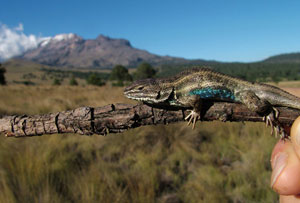
Climate change could wipe out one species in five, researchers say.
As many as one in five species of the world’s lizards could go extinct by 2080 because they can’t take the heat of climate change, an international research team reports.
Climate change could wipe out one species in five, researchers say.
As many as one in five species of the world’s lizards could go extinct by 2080 because they can’t take the heat of climate change, an international research team reports.
Over the next 70 years, warming temperatures could wipe out 39 percent of local lizard populations, as well as whole species, the researchers say in the May 14 Science. In fact, some local populations have already started succumbing to heat, the team says.
Even looking only at the local losses so far, “The paper is pretty shocking,” says evolutionary biologist David B. Wake of the
More than two dozen scientists created and verified a computer model to predict how lizards will cope with a warming climate, using air temperature records, studies of species body temperatures, and worldwide records of lizard locations.
 Air temperature records suggested that overheating could explain why lizards have vanished from otherwise acceptable habitats. Temperature is a big deal for lizards, which keep from frying or freezing up by moving to shadier or sunnier parts of their ranges.
Air temperature records suggested that overheating could explain why lizards have vanished from otherwise acceptable habitats. Temperature is a big deal for lizards, which keep from frying or freezing up by moving to shadier or sunnier parts of their ranges.
A widespread decline in lizard species, or even losses in a lot of local populations, could disrupt current ecosystems by reducing predation on bugs and cutting the food supplies of bigger animals that feed on lizards.
“Lizards are very efficient at turning insects into meat,” says Barry Sinervo of the University if
His concern about lizard declines started with failures to find certain lizards at a third of the European sites where they used to be. Then he and his colleagues in
To investigate the biology behind these disturbing trends, Sinervo and researchers led by Fausto Méndez-de-la Cruz of the National Autonomous University of Mexico in Mexico City set out artificial stand-ins for lizards, equipped with thermometers, at places where a particular Yucatán lizard species had been recorded.
Researchers monitored for how long during the day temperatures rose above limits that drive the lizards to seek cool shelter. Looking at these times in places where populations had disappeared gave researchers an idea of how much high-heat time was too much. The analysis showed that being confined to shade proved especially troublesome in spring, when females need plenty of food for reproduction.
Other biologists contributed data and records from other regions, eventually ending up with information about air and body temperature and lizard disappearances from species spanning five continents and 34 taxonomic families.
“I wouldn’t say this about my other research,” says coauthor Jack Sites of Brigham Young University in

 Previous page
Previous page Back to top
Back to top







